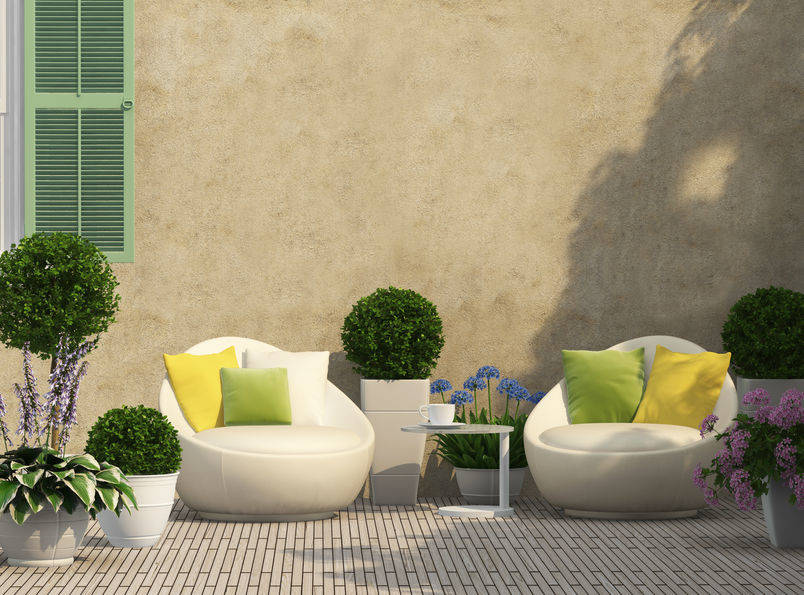Courtyards act as transitions between indoors, outdoors
Dear Gail: We live in an older neighborhood on a nice quiet street. We have a very large front yard and were thinking about adding a courtyard. We entertain a lot and want to have additional places for our guests to mingle. What are your thoughts on a front courtyard? As well as any decorating suggestions? — Dustin
Dear Dustin: I love the idea of using all of our living and outdoor space to however suits us the best. I recently removed my pool and put in a freestanding “pub porch.”
I always wanted a wraparound porch with rocking chairs. So the front has a white picket railing with apple green rocking chairs, and the back is set up as a pub. Perfect for an evening cocktail or afternoon lunch.
Courtyards have been in architecture since the early Romans times. They were developed to provide privacy from the noise of the outside world and add an outdoor garden where you could entertain, relax and enjoy the sunlight in your own special getaway.
I’ve lived in Las Vegas for 39 years, and I rarely saw courtyards in new homes. Of course, there were custom homes that had them but not many in tract communities until the Sun City developments, where most homeowners opt for courtyards.
It makes complete sense being we are fortunate enough to live in a climate that is conducive to outdoor living for 10 months out of the year. So now you see an abundance of courtyard designs in all price range homes. We are all looking for ways to relax and being outdoors in a tranquil setting can help lower our blood pressure and close the door on the work of the day.
Courtyard designs have evolved to increase the usable square footage of a home and to also incorporate the great outdoors. A courtyard can come in many shapes, sizes and purposes. Its main expression is to be a transition between the indoors and outdoors.
An entry courtyard gives a tranquil and welcoming feeling when entering. Being you have plenty of room, it can be a wonderful place for casual entertaining. Along with a place for a change of scenery from the family room for an after-dinner coffee and away from the television.
There are a couple of different options that you can investigate the costs of. As with any home improvement project, you can save money by doing it yourself, but please know your limits, especially if there will be any construction involved.
Your first step would be to determine how large of a courtyard you want to create and exactly where it will be placed in relation to your entry. Its shape and location need to relate to the shape of the house. You want it to appear as if it is an extension of your home and not a second-thought add-on.
Courtyards do not have to be completely surrounded by walls. Of course, that would be the ultimate for privacy and security but is not the most cost-effective option. Also, depending upon the amount of space that you have, which sounds like you have plenty, you don’t want to make it into a fortress-type entry.
One way to give yourself a private area without building walls is with the use of plants, furniture and a water feature. You’ll first want to expand your walkway into your courtyard space. You can remove your concrete path and pour a new slab or use pavers or flagstone, which I personally prefer.
Try to make the shape move free-flowing versus a square or rectangular. It’s more attractive and interesting. A winding path is more welcoming to stroll down versus a straight-ridged sidewalk. You can also give it a flowing feel by how you plantscape around the courtyard.
Next, look to see where you are going to enter and make it stand out. You could use a freestanding arched trellis to dramatize your entrance. Two large pieces of sculpture art or oversized plants will also give your entrance a private welcoming feel.
It all depends upon how open you want to be on the street. I know you mentioned it is a private street, but everyone has a different comfort level.
With your flooring in place and entrance set, now purchase larger plant containers with substantial foliage. They will act as your partial walls to give you privacy. Don’t surround yourself with them, but place enough so that when you’re sitting there, you feel secluded from the street and your neighbors.
Now add a focal feature. This could be a wonderful fountain, outdoor fireplace, artwork or a unique piece of furniture. Every room, whether indoor or out needs to have a focal point.
Next step is to add your furniture. Use pieces that are comfortable and attractive. Group conversation areas, as well as separate sitting and dining areas if you have the room.
We follow the same rules of design, so keep your conversation areas no more than 8 feet apart and do not line the perimeter of the area with furniture. Bring it into the courtyard and don’t be afraid to angle it.
Also, don’t forget your lighting. It makes all the difference in turning a dark area into festive and inviting. Add accent lighting on your plants as well as adequate lighting for when you’re entertaining. If you’re going to have any overhead covering, add an outdoor chandelier.
Courtyards are quaint and secluded sanctuaries that allow us to have a welcome reprieve from our busy days as well as gather and enjoy our guests. I hope you enjoy yours.
Gail Mayhugh, owner of GMJ Interiors, is a professional interior designer and author of a book on the subject. Questions may be sent by email to GMJinteriors@gmail.com. Or, mail to 7380 S. Eastern Ave., No. 124-272, Las Vegas, NV 89123. Her web address is www.GMJinteriors.com.























